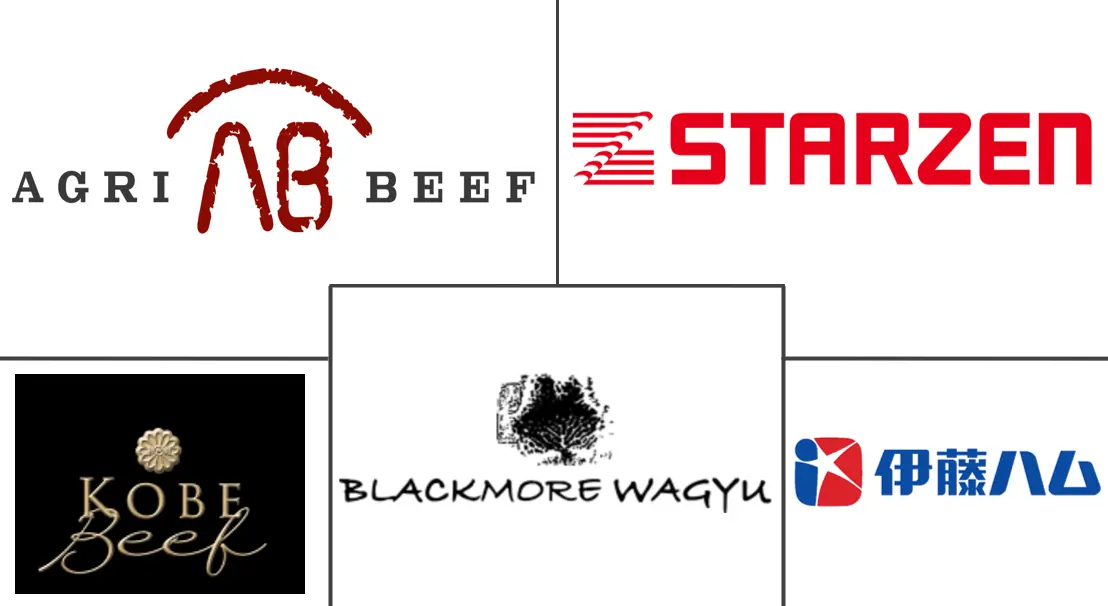Wagyu Beef Market Size and Share
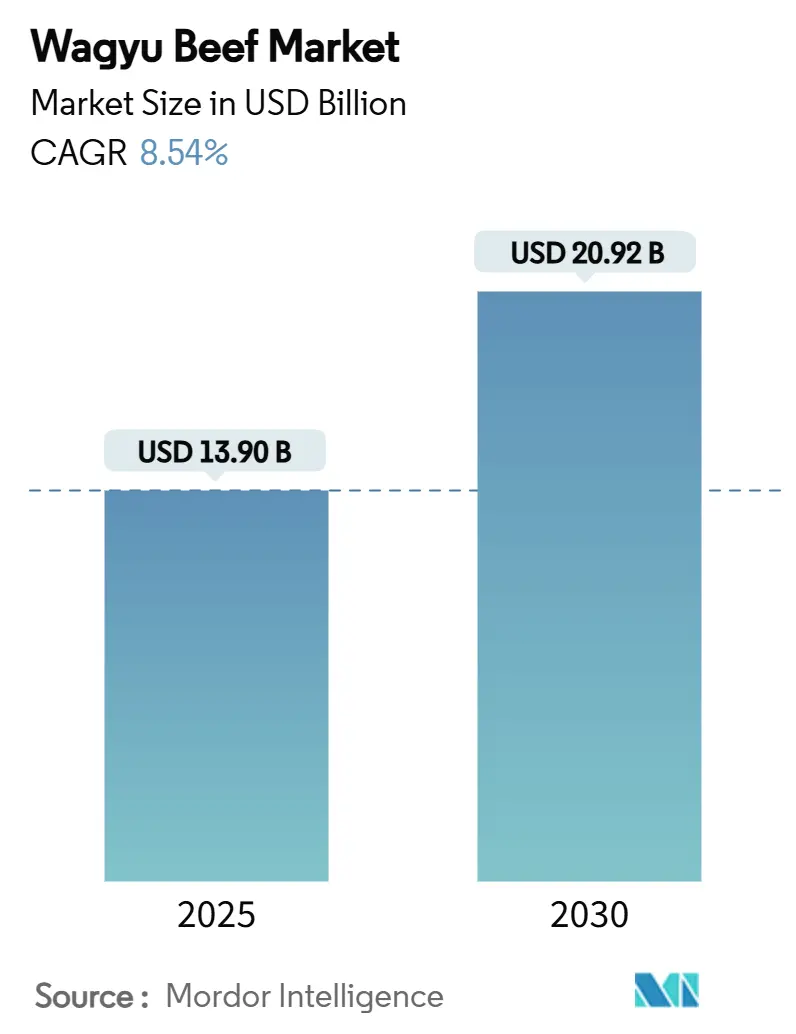
Wagyu Beef Market Analysis by Mordor Intelligence
The Wagyu beef market size reached USD 13.9 billion in 2025 and is projected to advance to USD 20.92 billion by 2030, reflecting an 8.54% CAGR that underscores strong global appetite for premium protein. Rapid adoption of genetic marker selection, AI-guided feeding programs, and blockchain traceability is improving production efficiency while sustaining the breed’s hallmark marbling. Growth is further supported by an expanding affluent middle class in Asia-Pacific, rising demand for culinary experiences in North America, and wider availability through direct-to-consumer platforms. Supply constraints remain, yet technological gains in embryo transfer and heat-tolerant breeding are easing bottlenecks and opening new geographies. Competitive intensity stays modest because the industry’s authenticity and traceability requirements create high entry barriers.
Key Report Takeaways
- By type, crossbred Wagyu dominated with 64.38% Wagyu beef market share in 2024, while full-blood Wagyu is on track for the fastest 11.37% CAGR through 2030.
- By breed, Japanese Black led with 79.48% of the Wagyu beef market size in 2024; Japanese Brown is slated to grow at a 9.82% CAGR to 2030.
- By grade, Grade A accounted for 58.94% of the Wagyu beef market size in 2024 and should expand at a 7.76% CAGR.
- By distribution channel, on-trade held 47.86% Wagyu beef market share in 2024, whereas off-trade is forecast to post an 8.48% CAGR.
- By region, Asia-Pacific secured 56.73% Wagyu beef market share in 2024; North America is projected to register an 8.86% CAGR through 2030.
Global Wagyu Beef Market Trends and Insights
Driver Impact Analysis
| Driver | (~) % Impact on CAGR Forecast | Geographic Relevance | Impact Timeline |
|---|---|---|---|
| Rising demand for premium and gourmet protein | +2.1% | Global, with concentration in North America & APAC | Medium term (2-4 years) |
| Expanding affluent middle class in emerging markets | +1.8% | APAC core, spill-over to MEA | Long term (≥ 4 years) |
| Growth of specialty butcher and online D2C channels | +1.4% | North America & EU, expanding to APAC | Short term (≤ 2 years) |
| Genetic and feed innovations improving calving yields | +1.2% | Global, with early adoption in Australia & US | Medium term (2-4 years) |
| Blockchain-enabled traceability boosting consumer trust | +0.9% | Global, led by developed markets | Short term (≤ 2 years) |
| Cross-border e-commerce easing import barriers | +0.8% | Global, particularly benefiting Japan exports | Medium term (2-4 years) |
| Source: Mordor Intelligence | |||
Rising Demand for Premium and Gourmet Protein
Global demand for premium and gourmet protein is driving the Wagyu beef market, as consumers increasingly pay a premium for its exceptional quality and culinary exclusivity. Celebrated for its marbling, tenderness, and health-conscious fat composition, Wagyu beef has become a staple in high-end restaurants and among discerning home chefs. This has led to heightened demand, particularly in urban centers, luxury dining venues, and through online specialty retailers. The rise of foodie culture, amplified by social media and endorsements from celebrity chefs, has catapulted Wagyu to cultural icon status. This has further widened its appeal among affluent consumers and culinary tourists in search of unique dining experiences. Moreover, advancements in Wagyu genetics, enhanced global trade access, and a commitment to ethical and sustainable production have made Wagyu more accessible, all while cementing its premium status in both established and emerging markets. With luxury dining trends, rising disposable incomes, and health-conscious preferences converging, the Wagyu beef sector is poised for growth, with projections indicating a CAGR exceeding 6% into the next decade.
Expanding Affluent Middle Class in Emerging Markets
As disposable incomes rise in Southeast Asia and the Middle East, there's a notable uptick in demand for premium, status-driven foods. In Japan, a resurgence in domestic tourism has buoyed purchases of Wagyu at hotels and restaurants, even as overall beef sales remained steady. The cultural significance of Wagyu, often gifted during celebrations, bolsters its repeat demand. Enhanced infrastructure, particularly in cold-chain logistics, is expanding retail access to Wagyu beyond major metropolitan areas. This trend, coupled with rising consumption volumes, empowers producers to scale operations and stabilize prices, creating a positive feedback loop for the Wagyu market. The burgeoning affluent middle class in emerging markets is reshaping global consumption patterns, driving a heightened appetite for premium proteins like Wagyu. Leading this growth are nations like China, India, and others in the Asia-Pacific region. As disposable incomes swell, consumers are increasingly gravitating towards luxury and gourmet food experiences. In Asia, where the local middle class is setting global consumption trends, there's a pronounced enthusiasm for status symbols like Wagyu beef. This is further amplified by urban lifestyles and a cultural reverence for fine dining. Such demographic shifts not only broaden the Wagyu's customer base but also spur distributors, retailers, and foodservice operators to delve into import channels, specialty retail, and bespoke Wagyu offerings tailored for this discerning consumer class.
Growth of Specialty Butcher and Online D2C Channels
Specialty butchers and direct-to-consumer platforms drive the Wagyu market, reshaping its accessibility. Producers, eager to derive more value from their products, are increasingly leaning towards direct-to-consumer beef sales. However, this shift demands substantial marketing investments and operational know-how. Notably, premium products like Wagyu have reaped the most benefits from this e-commerce expansion. Online platforms empower producers to share their stories—highlighting provenance, breeding methods, and quality certifications—directly with consumers, sidestepping traditional middlemen. The adoption of this channel was hastened in recent years, and many consumers have continued their online purchasing habits even after. Key technological advancements, such as enhanced cold chain logistics, subscription-based deliveries, and seamless digital payment systems, have minimized transaction friction. This diversification in channels not only lessens producers' reliance on conventional wholesale ties but also allows them to command premium prices through direct engagement with consumers.
Cross-Border E-Commerce Easing Import Barriers
Digital commerce platforms are breaking down traditional barriers in the international Wagyu trade. This shift allows smaller producers to tap into global markets, a space once dominated by larger exporters. A testament to this evolution is the Japan External Trade Organization's backing of the Universal Wagyu Mark. This mark aims to differentiate genuine Japanese Wagyu from its foreign counterparts, showcasing the role of digital certification in bolstering cross-border commerce[1]Australian Wagyu Association, “BREEDPLAN and Marbling Scores,” australianwagyu.com.au. Trade agreements, notably the Comprehensive and Progressive Agreement for Trans-Pacific Partnership (CPTPP), are further smoothing the path for Wagyu exporters by slashing tariffs on agricultural products. These digital platforms are not just facilitating transactions; they're fostering direct connections between international buyers and producers, diminishing the reliance on traditional import/export middlemen. Efforts like the mutual recognition of food safety standards and electronic health certificates are harmonizing regulations, making cross-border dealings more efficient. This trend is especially advantageous for premium products like Wagyu. Here, digital platforms excel at conveying quality attributes and provenance narratives, appealing to global consumers ready to pay top dollar for authenticity.
Restraint Impact Analysis
| Restraint | (~) % Impact on CAGR Forecast | Geographic Relevance | Impact Timeline |
|---|---|---|---|
| High production & finishing costs | -1.7% | Global, particularly acute in developed markets | Long term (≥ 4 years) |
| Limited purebred cattle supply outside Japan | -1.3% | Global, excluding Japan | Medium term (2-4 years) |
| Stringent animal-health and import regulations | -1.1% | Global, varying by jurisdiction | Short term (≤ 2 years) |
| Premium consumers shifting to plant-based alternatives | -0.8% | North America & EU primarily | Medium term (2-4 years) |
| Source: Mordor Intelligence | |||
High Production & Finishing Costs
Wagyu producers grapple with persistent challenges stemming from production cost inflation. Throughout the supply chain, margin pressures arise from feed costs, labor expenses, and the demands of regulatory compliance. In 2025, beef prices hit record highs. For instance, in May 2025, ground beef averaged USD 5.98 per pound, marking a 16.2% rise from the prior year, as reported by NACS Daily. Wagyu cattle, needing an extended finishing period of 21 months—significantly longer than conventional beef cycles—face heightened input costs and working capital demands. Labor shortages in agriculture are fueling wage inflation. Ranchers, in particular, struggle to find skilled workers adept at the specialized handling and care protocols required for Wagyu. Rising costs tied to regulatory compliance—spanning animal welfare, environmental monitoring, and food safety—add layers of complexity and expense to operations. Furthermore, volatility in energy costs impacts feed production, processing, and cold chain logistics, leading to unpredictable cost structures that challenge pricing strategies. Such mounting cost pressures could stifle market expansion, squeezing producer profitability and risking retail prices that exceed what consumers are willing to pay.
Stringent Animal-Health and Import Regulations
Wagyu producers and exporters face heightened operational costs and barriers to market expansion due to the complexities of international trade regulations. Recent developments underscore the impact of animal health concerns on trade: the UK's suspension of bovine offal imports from Japan, a response to lumpy skin disease outbreaks, highlights the fragility of established trade relationships UK Government. Similarly, China's December 2024 safeguard investigation into global beef imports casts a shadow of uncertainty over exporters eyeing major markets. In Europe, outbreaks of foot and mouth disease prompted sweeping import restrictions, with the UK extending controls to personal imports from the entire European Economic Area. Smaller producers find themselves disproportionately burdened by the compliance costs associated with health certifications, testing protocols, and documentation. This intricate regulatory landscape appears to favor larger, established players, equipped with the resources to adeptly navigate compliance, potentially stifling market competition and innovation.
Segment Analysis
By Breed: Japanese Black Command and Japanese Brown Upswing
In 2024, Japanese Black cattle claimed a commanding 79.48% share of the Wagyu beef market. Leveraging global brand recognition and advanced genomic selection tools like BREEDPLAN, producers ensure consistent quality at scale[2]Japan External Trade Organization, “Global Wagyu Genetics Export Data,” jetro.go.jp. Collaborations between Australian feedlots and Japanese buyers bolster demand stability. Meanwhile, targeted marketing initiatives enlighten chefs on the best preparation techniques. Continuous tweaks in feeding regimes are elevating marble scores, solidifying the breed's premium pricing edge in major markets.
Japanese Brown, boasting a 9.82% CAGR, is emerging as the standout contender in the Wagyu beef arena. Its adaptive heat tolerance, coupled with a unique umami flavor, has caught the attention of chefs seeking menu distinction. Breeders spanning from Texas to Thailand are adopting Brown lines, not only to counteract heat stress but also to curtail production losses. Collaborations with academic institutions are refining carcass evaluations, ensuring sensory appeal, and securing foodservice contracts. Triumphs at global tasting events further underscore the promising ascent of Japanese Brown.
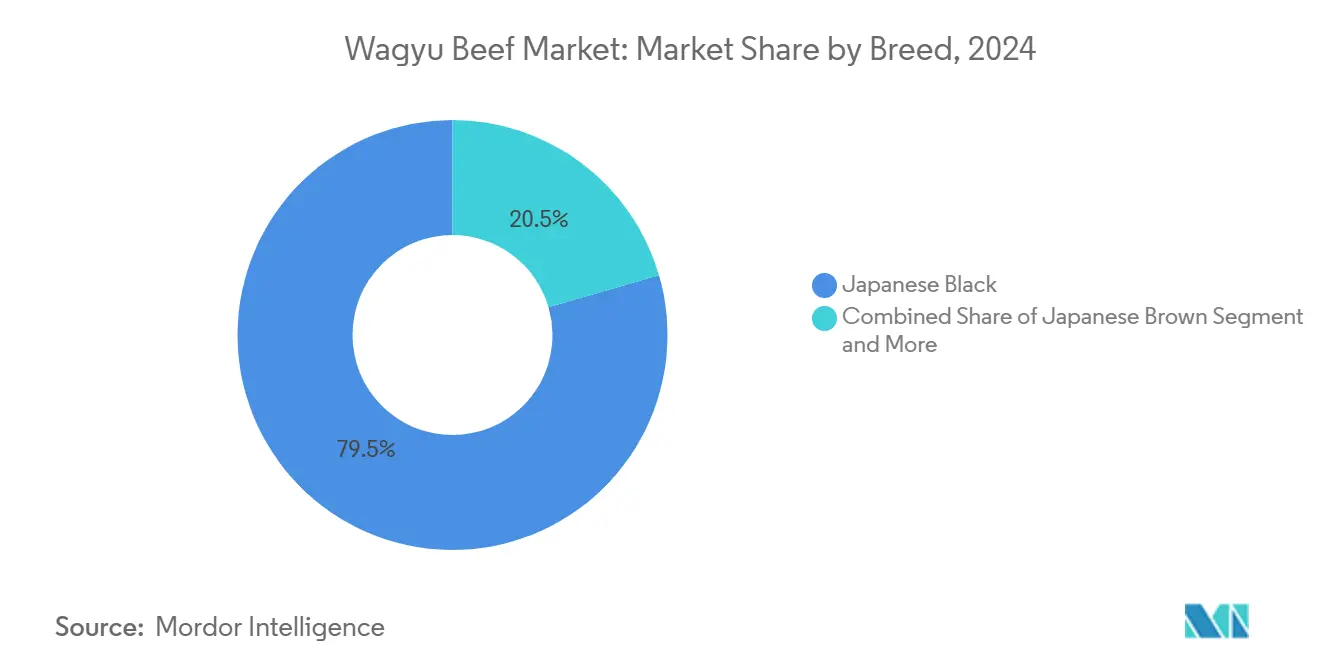
Note: Segment shares of all individual segments available upon report purchase
By Grade: Grade A Leads While Technology Elevates Precision
In 2024, Grade A Wagyu commanded a dominant 58.94% share of the Wagyu beef market and is projected to achieve a robust 7.76% CAGR through 2030. Its unique blend of intense marbling and reasonable pricing appeals to upscale casual dining and specialty retail sectors, both of which are increasingly demanding consistent specifications. To address this, certification bodies are leveraging blockchain and AI video grading tools, ensuring accurate verification of marbling and color, and minimizing subjective discrepancies. These advancements bolster confidence among distributors and chain restaurants, leading to repeat orders and solidifying Grade A's preeminence in the Wagyu beef arena.
Meanwhile, Grades B and C play a pivotal role for price-sensitive institutional buyers. Cutting-edge innovations, like near-infrared spectroscopy, are being employed in processing facilities to mitigate misclassification, thereby enhancing inventory planning. Grade B caters to the aspirational consumer demographic, while Grade C finds its niche in quick-service menus, where blended ground Wagyu offers a touch of premium allure at a managed cost. The ongoing embrace of precise grading not only protects brand equity but also nurtures a sustained, multilayered demand.
By Distribution Channel: On-Trade Heritage and Off-Trade Acceleration
In 2024, premium steakhouses, hotel banquets, and omakase counters—collectively termed on-trade venues—commanded a dominant 47.86% share of the Wagyu beef market. Chefs, through tableside education and theatrical preparation, actively shape and reinforce the narrative of Wagyu's artisanal craftsmanship. With tourism rebounding, particularly in hotspots like Japan and Dubai, flagship restaurants have emerged as experiential showcases, drawing attention to the Wagyu beef market. Furthermore, strategic loyalty partnerships with local ranches ensure a supply of exclusive cuts, setting these venues apart in the competitive fine-dining arena.
Meanwhile, off-trade channels are witnessing an 8.48% CAGR, buoyed by the maturation of omnichannel retail. Supermarkets are enhancing shopper experiences by establishing dedicated chilled display zones. Online platforms are not just selling but also educating, offering bundled cooking tutorials, chef-led livestreams, and enticing zero-interest installment plans, making Wagyu more accessible to affluent newcomers. Specialty butchers are taking it a step further, curating limited-edition cuts and employing QR-code traceability to validate authenticity. Collectively, these strategies are broadening access and establishing consistent revenue streams for the Wagyu beef market.

By Type: Crossbred Stability Versus Full-Blood Momentum
In 2024, crossbred Wagyu commanded a 64.38% share of the Wagyu beef market. This dominance is attributed to hybrid vigor, which not only shortens finishing cycles but also enhances adaptability to varying climates. Producers appreciate the crossbreds' heightened disease resistance and superior feed conversion, leading to larger batch sizes and more consistent output. While these hybrid animals achieve the signature marbling of Wagyu, they do so at price points that are more palatable for premium retail chains. With breeding programs honing in on genomic markers, there's a noticeable uptick in consistency and a decline in second-grade losses. This trend further solidifies the crossbreed's stronghold in the Wagyu beef market. Moreover, channel partners are leaning towards crossbred lines, as their supply volumes align more closely with the demands of restaurants and grocery stores.
Full-blood Wagyu is poised to experience the swiftest growth, targeting an impressive 11.37% CAGR. By 2030, its market contribution is set to see a significant uptick. Ultra-premium buyers, in pursuit of authenticity, are setting auction records, exemplified by Mayura Station’s heifer fetching a staggering USD 130,000. Enhanced embryo transfer techniques and rigorous DNA registry services are bolstering traceability, making them attractive to both collectors and gourmet chefs. As top-tier genetics make their way beyond Japan and Australia, niche herds are emerging in the U.S. and South America. While the supply remains constrained, it empowers exporters with heightened bargaining leverage and increased visibility. This segment's allure not only reinforces Wagyu's status as a luxury commodity but also sustains its price premiums, driving consistent revenue growth in the Wagyu beef market.
Geography Analysis
Asia-Pacific retained 56.73% Wagyu beef market share in 2024, anchored by robust domestic demand in Japan and export prowess in Australia. Japan’s Wagyu designation law safeguards authenticity, driving trust among consumers who spend freely on gift-giving occasions. Australian ranches benefit from abundant grazing land and integration with feedlot infrastructure, enabling year-round export volumes. Bilateral trade agreements such as the CPTPP further lower tariffs, cementing Asia-Pacific’s dominance in the Wagyu beef market.
North America delivered the fastest 8.86% CAGR owing to expanding specialty retail networks and culinary media coverage. Technological precision in U.S. breeding programs shortens genetic improvement cycles, boosting marbling scores to satisfy discerning steakhouse chefs. Canada’s regained beef access to Japan, effective in 2023[3]Agriculture and Agri-Food Canada, “Japan Market Access 2023,” agr.gc.ca, spurs producer investment in full-blood herds. Mexico’s middle class shows rising interest in premium imported proteins, adding incremental demand across the continent.
Europe records steady growth underpinned by well-established gourmet culture and traceability regulations that dovetail with Wagyu’s transparency strengths. High-income urban centers such as Paris, Milan, and London continue to attract fine-dining patrons who value the breed’s mouthfeel and umami. Import protocols, while stringent, streamline cross-border logistics through harmonized veterinary certificates. South America and the Middle East show emerging promise as logistics networks improve and tourism-driven hospitality seeks new signature menu items. Continued investments in cold-chain capacity will shape regional uptake of the Wagyu beef market through 2030.
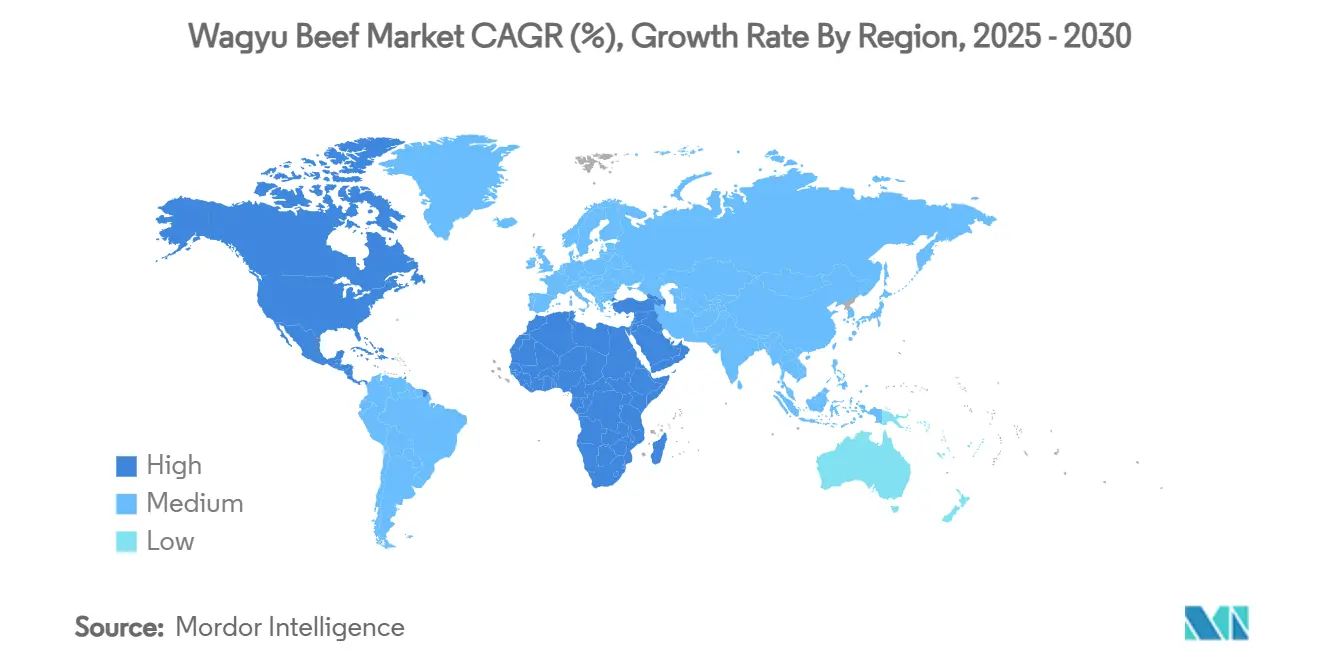
Competitive Landscape
The Wagyu beef market remains fragmented, giving nimble producers space to differentiate. Japanese integrators like Starzen Co., Ltd. deploy cradle-to-fork control, pairing breeding farms with distribution arms to secure consistent marble grades. Australian players Blackmore Wagyu and Rangers Valley Cattle Station emphasize data-driven genetic selection and carbon-neutral certifications to command premiums. In the United States, Snake River Farms pioneered D2C frozen steak delivery, expanding brand reach while learning real-time consumer preferences.
Strategic alliances between retailers and ranchers reshape supply chains. Walmart’s minority stake in Sustainable Beef LLC aims to guarantee a high-grade supply for its growing premium meat aisle, illustrating big-box interest in value chain control. Technology startups such as Halter provide virtual fencing systems that reduce labor and enhance pasture rotation. Legacy processors like Cargill inject USD 90 million into automation that limits trim waste, lifting yields without compromising humane handling.
Alternative proteins create adjacent competition, yet Wagyu’s cultural cachet shields it from direct substitution. Producers counter plant-based narratives by showcasing methane-reducing feed additives and lifecycle assessments verifying emissions cuts below standard beef. Certification programs emphasize animal welfare progress, including the first homozygous polled Wagyu calf that eliminates dehorning without genetics compromise. Authentic heritage, consistent eating quality, and transparent supply chains remain the primary levers sustaining competitive advantage in the Wagyu beef market.
Wagyu Beef Industry Leaders
-
Starzen Co., Ltd.
-
Itoham Yonekyu Holdings Inc.
-
Agri Beef Co.
-
Kobe Beef Marketing & Distribution Promotion Association
-
Blackmore Wagyu
- *Disclaimer: Major Players sorted in no particular order
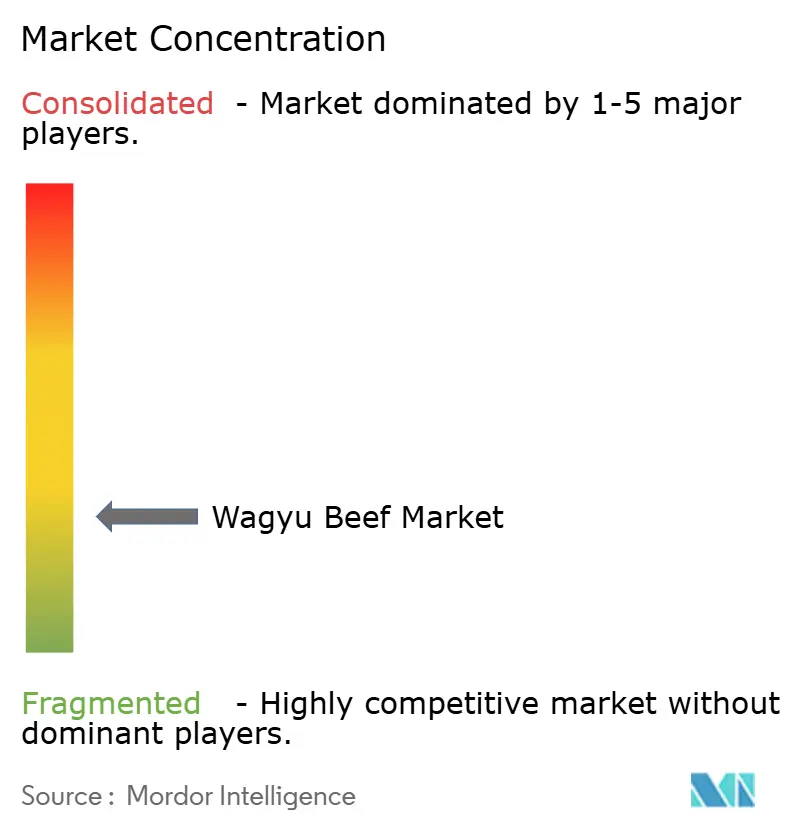
Recent Industry Developments
- April 2025: Young American Food Brands, commonly referred to as Miami Beef, revealed its acquisition of Best Provision Co. Inc., a Newark, NJ-based processor renowned for its premium smoked and cooked meats. Leveraging Best's expertise in smoking, Young American enhanced its offerings in the smoked snack and smoked beef segments, introducing products like the newly launched Wagyu sausages and brisket burgers.
- March 2025: Jack’s Creek, the esteemed Australian beef producer and two-time winner of the prestigious ‘World’s Best Steak’ title, has clinched its inaugural exclusive retail listing in the UK with Ocado Retail. Set to hit the shelves with the new Wagyu X range boasts four premium offerings: Jack’s Creek Wagyu X Sirloin, Ribeye, Fillet, and Rump, all featuring rich marbling and grain-fed Wagyu quality, with prices starting at £17.
- September 2024: In a move to elevate its premium offerings, Waitrose added top-tier British wagyu beef to its No.1 range. Their product range includes five new wagyu in stores: meatballs, sirloin steak, rump steak, ribeye steak, and burgers.
Global Wagyu Beef Market Report Scope
| Full-blood Wagyu |
| Purebred Wagyu |
| Crossbred Wagyu |
| Others (Wagyu-Angus, Wagyu-Charolais) |
| Japanese Black |
| Japanese Brown |
| Japanese Shorthorn |
| Japanese Polled |
| Grade A |
| Grade B |
| Grade C |
| On-Trade | |
| Off-Trade | Supermarkets/Hypermarkets |
| Meat Specialty Stores | |
| Online Retailers | |
| Others |
| North America | United States |
| Canada | |
| Mexico | |
| Rest of North America | |
| Europe | Germany |
| United Kingdom | |
| France | |
| Italy | |
| Spain | |
| Russia | |
| Rest of Europe | |
| Asia-Pacific | Japan |
| Australia | |
| China | |
| South Korea | |
| New Zealand | |
| India | |
| Singapore | |
| Thailand | |
| Indonesia | |
| Rest of Asia-Pacific | |
| South America | Argentina |
| Brazil | |
| Chile | |
| Rest of South America | |
| Middle East and Africa | United Arab Emirates |
| Saudi Arabia | |
| South Africa | |
| Turkey | |
| Rest of Middle East and Africa |
| By Type | Full-blood Wagyu | |
| Purebred Wagyu | ||
| Crossbred Wagyu | ||
| Others (Wagyu-Angus, Wagyu-Charolais) | ||
| By Breed | Japanese Black | |
| Japanese Brown | ||
| Japanese Shorthorn | ||
| Japanese Polled | ||
| By Grade | Grade A | |
| Grade B | ||
| Grade C | ||
| By Distribution Channel | On-Trade | |
| Off-Trade | Supermarkets/Hypermarkets | |
| Meat Specialty Stores | ||
| Online Retailers | ||
| Others | ||
| By Geography | North America | United States |
| Canada | ||
| Mexico | ||
| Rest of North America | ||
| Europe | Germany | |
| United Kingdom | ||
| France | ||
| Italy | ||
| Spain | ||
| Russia | ||
| Rest of Europe | ||
| Asia-Pacific | Japan | |
| Australia | ||
| China | ||
| South Korea | ||
| New Zealand | ||
| India | ||
| Singapore | ||
| Thailand | ||
| Indonesia | ||
| Rest of Asia-Pacific | ||
| South America | Argentina | |
| Brazil | ||
| Chile | ||
| Rest of South America | ||
| Middle East and Africa | United Arab Emirates | |
| Saudi Arabia | ||
| South Africa | ||
| Turkey | ||
| Rest of Middle East and Africa | ||
Key Questions Answered in the Report
What is the current value of the Wagyu beef market?
The Wagyu beef market reached USD 13.9 billion in 2025 and is forecast to grow to USD 20.92 billion by 2030.
Which segment is expanding the fastest?
Full-blood Wagyu is projected to register an 11.37% CAGR, the quickest among all type segments.
Why is Asia-Pacific the largest regional market?
Cultural heritage, strong domestic demand in Japan, and Australia’s export capacity secure 56.73% regional share in 2024.
How are producers reducing environmental impact?
Innovations include methane-reducing feed additives such as Bovaer and precision feeding systems that cut waste.
Page last updated on:
